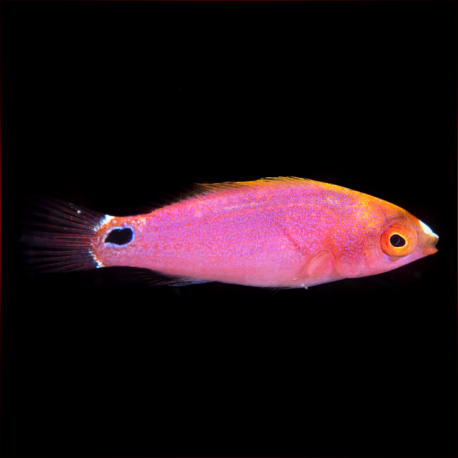More info
Datasheet
| Minimum Tank Size | 400 litres / 105.67 US gallons |
| Maximum Size | 12.0cm / 4.72inches |
| Reef Compatible | Always reef safe |
| Temperament | Might be aggressive towards food competitors |
| Temperature | 22.2°C / 71.96°F - 25.6°C / 78.08°F |
| Specific Gravity | 1.020-1.025 |
| Carbonate Hardness | 8-12 |
| pH | 8.1-8.4 |
General DescriptionThe Exquisite Wrasse, scientifically known as Cirrhilabrus exquisitus, belongs to the Labridae family. These fish are renowned for their vibrant colors and are generally well-suited for aquarium life. They are predominantly peaceful, although some individuals may exhibit aggression towards closely related species.
Aquarium SuitabilityThis species is deemed suitable for most aquarium setups. However, they are known to be sensitive during transportation and acclimatization. Exquisite wrasses require a tank of at least 100 gallons, ideally 200 gallons or more, with ample swimming space and hiding spots amongst live rocks. It is recommended to observe them closely during feeding and ensure they are active, especially larger specimens.
Care and HardinessExquisite wrasses are considered to have an average level of hardiness. They are known to be shy and docile, emphasizing the importance of appropriate tank mates. These fish need a varied and high-quality diet that includes frozen and flake foods to maintain their vibrant colors. Feeding should occur at least twice daily, with a focus on small crustaceans and zooplankton.
Reef SuitabilityExquisite wrasses are always deemed reef-safe, making them a great addition to reef aquariums. They help control unwanted invertebrates like flatworms and pyramid snails. However, they may display aggression towards other fish competing for food.
Aquarium SetupA suitable aquarium for the Exquisite wrasse should have a lid to prevent jumping, secure overflow, and ample swimming space. Live rocks for hiding are essential, and the tank must be well-aerated. Maintaining stable water conditions with a temperature between 22.2-25.6 degrees Celsius, a pH of 8.1-8.4, a specific gravity of 1.020-1.025, and a carbonate hardness (KH) of 8-12 is crucial.
BehaviourMale Exquisite wrasses can be territorial with each other but generally coexist peacefully in a group with multiple females. They may change color and exhibit flashy displays during courtship. During the night, these fish, like Fairy Wrasses, cocoon themselves in mucus between rocks for sleep. Notably, males may lose color if not kept with females.
Feeding and DietExquisite wrasses feed on small crustaceans like Krill, Mysis, and Artemia, as well as zooplankton such as Cyclops and pods. It's essential to feed them multiple times a day, especially upon introducing them to a new environment. Maintaining a diet rich in pigment can help retain their vibrant colors in captivity.
DimorphismThis species is hermaphroditic, being capable of changing gender from male to female and vice versa. Males may lose color in the absence of females, emphasizing the importance of keeping them in a group setting.
Habitat and DistributionExquisite wrasses are found in the Indo-Pacific region, ranging from East Africa to Sodwana Bay, South Africa, and east to the Tuamoto Islands. They inhabit coral reefs and are often observed swimming in open waters with rich biodiversity.

